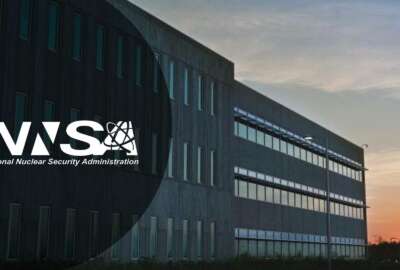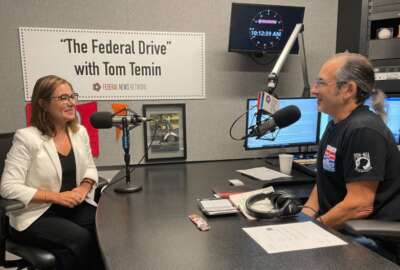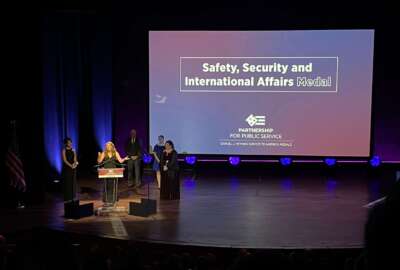
Meet the team leaders behind last year’s successful fusion experiment
It didn't last very long, but scientists at the National Nuclear Security Administration (NNSA) did run a test that resulted in nuclear fusion late last year. F...
It didn’t last very long, but scientists at the National Nuclear Security Administration (NNSA) did run a test that resulted in nuclear fusion late last year. Fusion means the reaction put out more energy than the input to produce it. The proof of concept got lots of acclaim. And it produced finalists in the Service to America Medals program. Federal Drive with Tom Temin spoke with those Sammies finalists: Dr. Sarah Nelson, Director of NNSA’s Defense Programs Office and Dr. Samantha Calkins, Program Manager for High Density and Ignition Science.
Interview Transcript:
Tom Temin Let’s begin with what actually happened. I mean, this was not something that was large scale that you could observe with a human eye like Los Alamos big boy test. What really happened? Tell us the layout physically and what you actually did.
Samantha Calkins I can take that one Tom, Samantha. So really, you got to think about how [National Ignition Facility (NIF)] works. And basically it starts with just a weak little initial laser pulse that’s split and amplified multiple times until there’s exactly 192 main laser amplifier beams. And those are guided by mirrors into amplifiers filters to ensure that beam is uniform, smooth, just pristine quality beam. And that beam is processed into these quads. So that’s like 2×2 arrays of beams. They’re transported into a target chamber. And that target chamber is really where the experiment happens. The beams are focused into the end of a cylinder that’s called a whole rom. And the whole rom holds a tiny little hydrogen fuel. And just for some context, this whole rom is is about the size of the top of a pencil. That little eraser. There you go, Sarah’s got a picture of it there. And so that laser energy that’s focused inside, it’s inside the surface of the whole rom where it’s focused, that creates a bunch of x rays which blow off the capsule fuel wall, resulting in a rocket like implosion. And that compresses the fuel. So the core reaches about 100 times the density of lead. So that’s really, really dense. This causes hydrogen atoms to fuse creating helium nuclei, and that releases a whole bunch of energy, hydrogen, neutrons. And if this implosion is symmetrical and you’ve got just the perfect conditions for compression and temperature, that’s really going to create what happened on Dec.5 where more energy was released than the energy that was put in. And besides that, it had to also overcome a bunch of cooling effects that the X-ray losses, electron conduction and implosion expansion that really would kill any kind of ignition condition. It was an amazing feat that happened on Dec. 5.
Tom Temin Yeah. I’m going to have you to our next outdoor cookout because this really fascinating piece of recitation, honestly. Well, a lot of the emphasis in the popular press was someday we’ll have fusion energy. And that’s kind of a long shot at this point. And but we know that there’s a proof of concept. Also interesting and not as widely reported, though, was how this can help the NNSA’s own mission of evaluating nuclear warheads and understanding the internals of what’s going on with them. In an age when we are proscribed by treaty from blowing them up to make sure they work. Dr. Nelson, Maybe talk about that a little bit.
Sarah Nelson Sure. Happy to, Tom. So that’s absolutely right. There has been a lot of coverage in the press about the energy implications for the experiment at the National Ignition Facility out at the Lawrence Livermore National Lab last December. But NIF was actually built for stockpile stewardship purposes. And already the program and our research is benefiting from the ignition experiment in December and the repeat experiments that we’ve had subsequent to that for understanding nuclear weapons conditions. Because the conditions that Samantha described just previously are those that occur in the Sun and those that occur should a nuclear weapon detonate. And as you rightly mentioned, since 1992, we have not detonated a nuclear weapons test. And this is one of the many ways that science based stockpile stewardship helps inform and ensure that we maintain a safe, secure, reliable stockpile in the absence of that testing. So we’re actually using these data already to help the stockpile.
Tom Temin It sounds like it’s something that is an almost an artificial intelligence or a data application, a way of I don’t know. Are you able to measure what’s going on inside a nuclear weapon? Is there any way of intuiting what’s going on inside under the shield that’s on top of it, to know that, I mean, the ultimate goal is to know that if it had to blow up, it would. Correct?
Sarah Nelson And that’s the purpose of the program that Samantha and I are in. And so I’m the acting director for the Office of Experimental Sciences within an NNSA defense program. Samantha is one of our program managers for high energy density physics and ignition science. And that’s one of the many activities that we have going on in the experimental science office. We do this work in partnership with our colleagues in advanced simulation computing and also the engineering and technical offices to ensure that our stockpile has the best and brightest working on those problems so that we don’t have to resume underground nuclear testing. So there’s a variety of ways that we can kind of look at things without resorting to those kind of tests.
Tom Temin We’re speaking with Dr. Sarah Nelson, she’s director of the Defense Programs Office of the Experimental Sciences at the National Nuclear Security Administration. And with Dr. Samantha Calkins, program manager of High Density Energy and Ignition Science for Stockpile Applications. Those titles in the work and the apparatus that you command strikes me that a nation that would have nuclear weapons needs to have the infrastructure of brains and technology to operate it and maintain it responsibly. I’m getting that message pretty strongly from this interview, and probably not the case of every nation that has or would have these.
Sarah Nelson So I can’t really comment on what other nations do or do not have, but I know that it is an absolute priority for the NNSA and the Department of Energy to maintain our skilled workforce, especially as we get farther and farther away from that cadre of people that have experienced underground nuclear tests. And especially since we’re not doing them anymore. So having not only the great workforce, the skilled, experienced workforce that’s learned from those people, from that Cold War time to the facilities that we use, such as the National Ignition Facility and our other laboratories at Los Alamos and Sandia and the Nevada national security sites and other partner universities. We work together to try to maintain the really unique infrastructure that we have to support these highly specialized experiments that we need to run to underpin the reliability of the stockpile.
Tom Temin Sure. And since that experiment and since the receiving of finalist categories in the US, the Service to America Medals Program, what is your life been like? Because you are two very prominent women in STEM, and women in STEM is one of the national talked about priorities, but you’re living it day by day in a very high level.
Sarah Nelson I’ll go first, and then I’ll turn it over to Samantha for her perspective. So I get to do a lot of fun things like this. I get to talk to people about the work that we’ve done, why it’s important, what’s driven us to pursue careers like this. All the way back to my undergraduate alma mater recently did a little piece on me and in the college paper, which was pretty great. And it’s nice to be an advocate and, I won’t call it an ambassador, but I guess I just did for women in STEM and women in defense as well.
Tom Temin And Samantha?
Samantha Calkins So, yes, what has changed? When I think about the science that we’re doing within defense programs, I think we have now an opportunity to to keep on going, to push the boundaries of what the National Ignition Facility and what the Inertial Confinement Fusion program can do. And so right now, we’re working across the entire national program thinking about what is that future, what is the science plan we need to embark on in the next ten years? And so it’s really exciting being a scientist and being able to kind of look towards the future of what’s possible.
Tom Temin Sure. And just what are the prospects for Fusion being a practical function? I kind of like it to quantum computing. Yes, there are small scale quantum computers, but you have to freeze something to almost absolute zero. And so the apparatus to do that makes a actual commercial scale quantum computer, nothing. We’re going to see some people say never. Some people say, well, maybe 10, maybe 50 years to get enough qubits to be able to do real computational science. What about fusion? That strikes me as kind of the same conundrum. Yes, we can show that it works, but to get it to where you can plug your toaster into it. Could that happen in any reasonable time period?
Samantha Calkins I’ll leave the fusion energy side to Sarah. She can talk that in a moment. But for the actual Stockpile Stewardship program, we are using this platform now. As Sarah mentioned, we’re not waiting years. We’re using it now to inform information on materials, better understand and assess the performance of our aging stockpile, which is really important for us. And so we don’t have to wait years. We can use this now, we can have these extreme conditions. That’s what we can do.
Copyright © 2024 Federal News Network. All rights reserved. This website is not intended for users located within the European Economic Area.
Tom Temin is host of the Federal Drive and has been providing insight on federal technology and management issues for more than 30 years.
Follow @tteminWFED





